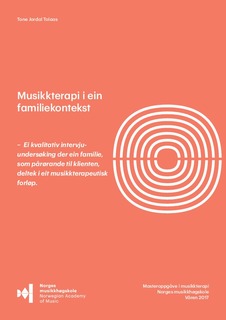| dc.contributor.advisor | Frisk, Rita Strand | |
| dc.contributor.author | Tolaas, Tone Jordal | |
| dc.date.accessioned | 2017-08-22T09:46:48Z | |
| dc.date.available | 2017-08-22T09:46:48Z | |
| dc.date.issued | 2017 | |
| dc.identifier.uri | http://hdl.handle.net/11250/2451397 | |
| dc.description | Norges musikkhøgskole. Masteroppgave. Musikkterapi | nb_NO |
| dc.description.abstract | I denne studia utforskas ein familie sin eigen oppleving av å delta i eit musikkterapitilbod ved Nydalen voksenopplæring som pårørande til klienten Therese. Studia er vitskapsfilosofisk og metodologisk forankra i fenomenologien. Gjennom metoden semi-strukturerte kvalitative forskingsintervju fortel kvar av informantane sine personlege opplevingar av deltakinga, og dette gir eit unikt innblikk i korleis musikkterapi kan vere til hjelp for familiar i sårbare situasjonar. Gjennom analysemetoden interpretative phenomenological analysis (IPA) blei svara til informantane systematisert og viktige fellestrekk tredde fram. Informantane sine forteljingar avdekker verknader av musikkterapien som blei plassert i fire kategoriar; 1) Individet, 2) Familien, 3) Verknader for Therese og 4) Ringverknader. Kvar av kategoriane har underkategoriar visualisert som ein modell i kapittel 2. Funna blir så drøfta i lys av teoriar frå musikkterapien og sosiologien | nb_NO |
| dc.description.abstract | This study explores a family’s own experience with participating in a weekly music therapy session at Nydalen voksenopplæring, as the next of kin to the client Therese. The study has a phenomenological basis through its fundament in philosophy of science and methodology. Through semi-structured qualitative interviews, each of the informants’ personal experiences with participating are unveiled, and this is a unique take on how music therapy can be helpful to families in vulnerable situations. The informants’ stories are systematically analysed through the analytic procedure interpretative phenomenological analysis (IPA). The informant’s reports on the consequences of participating are placed in four categories; 1) The Individual, 2) The Famliy, 3) Consequences for Therese and 4) Reverberation. Each category has its own sub-categories, visualized in a model in chapter 2. The results will then discussed in light of theories from the music therapy and sociology literature | nb_NO |
| dc.language.iso | nno | nb_NO |
| dc.publisher | Norges musikkhøgskole | nb_NO |
| dc.relation.ispartofseries | Norges musikkhøgskole. Masteroppgave. Musikkterapi;2017 | |
| dc.subject | meining | nb_NO |
| dc.subject | samanheng | nb_NO |
| dc.subject | sence of coherence | nb_NO |
| dc.subject | affordance | nb_NO |
| dc.subject | appropriation | nb_NO |
| dc.subject | musikkterapi | nb_NO |
| dc.subject | fellesskap | nb_NO |
| dc.subject | aktørstatus | nb_NO |
| dc.subject | meaning | nb_NO |
| dc.subject | coherence | nb_NO |
| dc.subject | music therapy | nb_NO |
| dc.subject | community | nb_NO |
| dc.subject | sense of agency | nb_NO |
| dc.subject | increasing possibilities for action | nb_NO |
| dc.title | Musikkterapi i ein familiekontekst. Ei kvalitativ intervjuundersøking der ein familie som pårørande til klienten, deltek i eit musikkterapeutisk forløp | nb_NO |
| dc.type | Master thesis | nb_NO |
| dc.subject.nsi | VDP::Humaniora: 000::Musikkvitenskap: 110::Musikkterapi: 113 | nb_NO |
| dc.source.pagenumber | ix, 64 s. | nb_NO |
